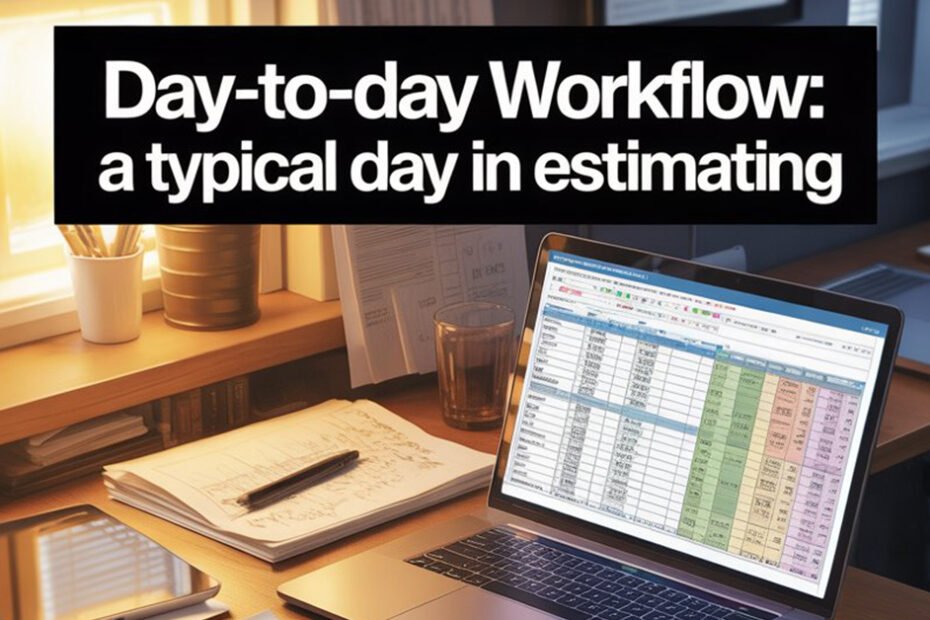Construction estimating is a fast-paced role that demands attention to detail, effective communication, and a solid grasp of costs and construction methods. Estimators are key players in the residential building process, laying the groundwork for accurate budgets and successful project delivery.
While no two days are exactly alike, a typical day in estimating follows a rhythm of reviewing plans, speaking with suppliers and trades, managing digital tools, and producing professional quotes. Here’s a closer look at how an estimator spends their day.
Morning Kick-Off: Reviewing Priorities and Project Files
Most estimators begin their day by reviewing their schedule and checking for any updates on current estimates or new jobs that have landed in the pipeline. Prioritisation is important—some projects may be on tight turnaround times, while others are waiting on supplier pricing or client feedback.
Many estimators work on multiple estimates simultaneously, so it’s common to revisit a few jobs throughout the day, updating quantities or rechecking costs based on the latest inputs.
Plan Analysis: Interpreting the Scope of Work
Once priorities are set, the estimator dives into reviewing architectural plans and construction documents. This part of the job requires strong spatial awareness and a solid understanding of residential construction methods.
The goal here is to identify every component of the build—from concrete slabs and wall framing to internal finishes and external landscaping. Estimators extract quantities and make notes on any items that need clarification from the builder or architect.
Takeoff Work: Measuring Materials and Labour
The takeoff is the core task of estimating. It involves systematically measuring the plans to calculate the quantity of materials and labour required. Estimators may use digital tools for this—drawing lines, areas, and volumes directly on screen, which speeds up the process and reduces errors.
Accuracy is critical. A missed measurement or incorrect quantity can skew the entire estimate. Estimators often double-check their work, especially on complex builds with multiple levels or detailed joinery.
Sourcing Pricing: Communicating with Suppliers and Trades
Once quantities are locked in, estimators begin sourcing prices. This involves contacting suppliers for up-to-date material costs and reaching out to trades for quotes on labour.
Good estimators build strong relationships with reliable suppliers and subcontractors. These connections help them secure accurate pricing quickly, which is especially valuable when working to tight deadlines.
This step also involves reviewing supplier price lists, factoring in delivery costs, and accounting for any known market fluctuations.
Building the Estimate: Combining Data into a Budget
With all the quantities and pricing gathered, estimators begin constructing the estimate. This is where everything comes together—material, labour, overheads, markups, and allowances.
Using software for construction estimating can streamline this process. Digital tools make it easier to input and adjust data, track versions of estimates, and maintain consistency across different jobs. Many platforms also allow builders to store templates, apply historical costs, and instantly update prices when supplier lists change.
Estimates must be both detailed and clear, often including breakdowns by category (e.g., site works, framing, roofing) and by trade (e.g., electrical, plumbing, carpentry).
Generating a Quote: Presenting the Information Professionally
Once the internal estimate is approved, the estimator turns it into a client-facing quote. This document outlines the full scope of the work, costs, allowances, and any exclusions.
Professional presentation is key. A good quote is easy to understand, visually clear, and builds trust with the client. It should reflect the builder’s brand and communicate the value of the work being delivered—not just a total price.
Some digital platforms allow estimators to generate quotes directly from the estimate, saving time and avoiding re-entry errors.
Client and Team Communication: Answering Questions and Clarifying Scope
Estimators often spend part of their day fielding questions—from clients who want to better understand a quote, or from project managers and site supervisors needing clarification on allowances or quantities.
This communication is vital to ensure everyone is aligned before work begins. It also helps catch potential issues early, avoiding costly misunderstandings during the build.
Wrapping Up: Reviewing and Logging Estimates
At the end of the day, estimators typically review the status of all open estimates, log any updates, and prepare for the next day’s tasks. Whether it’s following up on supplier pricing or revisiting a job that’s on hold, good record-keeping helps maintain momentum and ensures no detail is missed.
Conclusion: A Role That Balances Precision with Practicality
Estimating is a blend of technical skill, industry knowledge, and people management. A typical day involves more than numbers—it’s about interpreting plans, making informed assumptions, and ensuring that builders are quoting jobs that will make financial sense once on site.
With the support of estimating software for building, estimators can reduce admin time, improve accuracy, and respond more quickly to opportunities. It’s this balance of technology and expertise that makes estimating such a vital part of every successful construction business.
